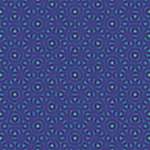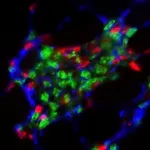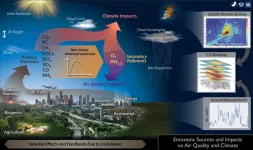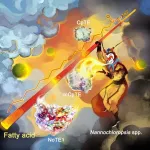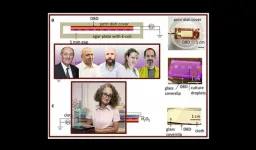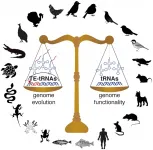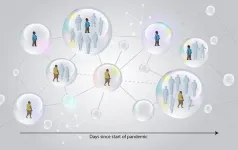(Press-News.org) Mathematicians and engineers at the University of Utah have teamed up to show how ultrasound waves can organize carbon particles in water into a sort of pattern that never repeats. The results, they say, could result in materials called "quasicrystals" with custom magnetic or electrical properties.
The research is published in Physical Review Letters.
"Quasicrystals are interesting to study because they have properties that crystals do not have," says Fernando Guevara Vasquez, associate professor of mathematics. "They have been shown to be stiffer than similar periodic or disordered materials. They can also conduct electricity, or scatter waves in ways that are different from crystals."
Non-pattern patterns
Picture a checkerboard. You can take a two-by-two square of two black tiles and two white (or red) tiles and copy and paste to obtain the whole checkerboard. Such "periodic" structures, with patterns that do repeat, naturally occur in crystals. Take, for example, a grain of salt. At the atomic level, it is a grid-like lattice of sodium and chloride atoms. You could copy and paste the lattice from one part of the crystal and find a match in any other part.
But a quasiperiodic structure is deceiving. One example is the pattern called Penrose tiling. At first glance, the geometric diamond-shaped tiles appear to be in a regular pattern. But you can't copy and paste this pattern. It won't repeat.
The discovery of quasiperiodic structures in some metal alloys by materials scientist Dan Schechtman earned a 2011 Nobel Prize in Chemistry and opened up the study of quasicrystals.
Since 2012, Guevara and Bart Raeymaekers, associate professor of mechanical engineering, have been collaborating on designing materials with custom-designed structures at the microscale. They weren't initially looking to create quasiperiodic materials--in fact, their first theoretical experiments, led by mathematics doctoral student China Mauck, were focused on periodic materials and what patterns of particles might be possible to achieve by using ultrasound waves. In each dimensional plane, they found that two pairs of parallel ultrasound transducers suffice to arrange particles in a periodic structure.
But what would happen if they had one more pair of transducers? To find out, Raeymaekers and graduate student Milo Prisbrey (now at Los Alamos National Laboratory) provided the experimental instruments, and mathematics professor Elena Cherkaev provided experience with the mathematical theory of quasicrystals. Guevara and Mauck conducted theoretical calculations to predict the patterns that the ultrasound transducers would create.
Creating the quasiperiodic patterns
Cherkaev says that quasiperiodic patterns can be thought of as using, instead of a cut-and-paste approach, a "cut-and-project" technique.
If you use cut-and-project to design quasiperiodic patterns on a line, you start with a square grid on a plane. Then you draw or cut a line so that it passes through only one grid node. This can be done by drawing the line at an irrational angle, using an irrational number like pi, an infinite series of numbers that never repeats. Then you can project the nearest grid nodes on the line and can be sure that the patterns of the distances between the points on the line never repeats. They are quasiperiodic.
The approach is similar in a two-dimensional plane. "We start with a grid or a periodic function in higher-dimensional space," Cherkaev says. "We cut a plane through this space and follow a similar procedure of restricting the periodic function to an irrational 2-D slice." When using ultrasound transducers, as in this study, the transducers generate periodic signals in that higher-dimensional space.
The researchers set up four pairs of ultrasound transducers in an octagonal stop sign arrangement. "We knew that this would be the simplest setup where we could demonstrate quasiperiodic particle arrangements," Guevara says. "We also had limited control on what signals to use to drive the ultrasound transducers; we could essentially use only the signal or its negative."
Into this octagonal setup, the team placed small carbon nanoparticles, suspended in water. Once the transducers turned on, the ultrasound waves guided the carbon particles into place, creating a quasiperiodic pattern similar to a Penrose tiling.
"Once the experiments were performed, we compared the results to the theoretical predictions and we got a very good agreement," Guevara says.
Custom materials
The next step would be to actually fabricate a material with a quasiperiodic pattern arrangement. This wouldn't be difficult, Guevara says, if the particles were suspended in a polymer instead of water that could be cured or hardened once the particles were in position.
"Crucially, with this method, we can create quasiperiodic materials that are either 2-D or 3-D and that can have essentially any of the common quasiperiodic symmetries by choosing how we arrange the ultrasound transducers and how we drive them," Guevara says.
It's yet to be seen what those materials might be able to do, but one eventual application might be to create materials that can manipulate electromagnetic waves like those that 5G cellular technology uses today. Other already-known applications of quasiperiodic materials include nonstick coatings, due to their low friction coefficient, and coatings insulating against heat transfer, Cherkaev says.
Yet another example is the hardening of stainless steel by embedding small quasicrystalline particles. The press release for the 2011 Nobel Prize in Chemistry mentions that quasicrystals can "reinforce the material like armor."
So, the researchers say, we can hope for many new exciting applications of these novel quasiperiodic structures created by ultrasound particle assembly.
INFORMATION:
Find the full study here.
UNIVERSITY PARK, Pa. -- Eating red meat may have a bad reputation for being bad for the heart, but new research found that lean beef may have a place in healthy diets, after all.
In a randomized controlled study, researchers found that a Mediterranean diet combined with small portions of lean beef helped lower risk factors for developing heart disease, such as LDL cholesterol.
Jennifer Fleming, assistant teaching professor of nutrition at Penn State, said the study suggests that healthy diets can include a wide variety of foods, such as red meat, and still be heart friendly.
"When you create a healthy diet built on fruits, vegetables, and other plant-based foods, it leaves room for moderate amounts of other foods like lean beef," Fleming said. "There are still ...
Irvine, CA - April 14, 2021 - A new study, led by the University of California, Irvine (UCI), reveals how chronic inflammation promotes muscle fibrosis, which could inform the development of new therapies for patients suffering from Duchenne muscular dystrophy (DMD), a fatal muscle disease.
Titled, "A Stromal Progenitor and ILC2 Niche Promotes Muscle Eosinophilia and Fibrosis-Associated Gene Expression," the study was published today in Cell Reports.
Chronic inflammation is a major pathological process contributing to the progression and severity of several degenerative disorders, including Duchenne muscular dystrophy (DMD). Studies directed at establishing a causal link between muscular ...
What are scientists passionate about? What do they actually do, and why does it matter? Answering questions like these is often part of public outreach efforts that, through demystifying the world of science for non-scientists, can increase appreciation for science and boost support for important research initiatives. Outreach can also make the sciences attractive and accessible to a broader diversity of people, who, in turn, can bring new ideas and perspectives.
"Science is having challenges in terms of getting the general public to support it and ...
BOSTON - The anti-diabetic drug phenformin may prompt stronger cancer-fighting activities than its sister compound metformin, a finding that could have major implications for current and future clinical trials investigating both agents for their anti-cancer potential, according to researchers at Massachusetts General Hospital (MGH). In a review article in Trends in Cancer, the team presented evidence that immunotherapies such as immune checkpoint inhibitors (which enable T cells to attack and kill cancer cells) in combination with phenformin may also be a promising way to repurpose this diabetic drug as an anti-cancer ...
One consequence of the coronavirus pandemic has been global restrictions on mobility. This, in turn, has had an effect on pollution levels in the atmosphere. Researchers from across the world are using this unique opportunity to take measurements, collect data, and publish studies. An international team led by Forschungszentrum Jülich's Institute of Climate and Energy Research - Troposphere has now published a comprehensive review providing an overview of results up to September 2020. The study also has its own dedicated website, where additional measurement data can be added to supplement and refine existing research results. At the same time, this collection of data allows scientifically substantiated predictions to be made about the ...
By combining the 'chassis' of an oil-producing microalgae with genes from a Cuphea plant, scientists from the Single-Cell Center, Qingdao Institute of BioEnergy and Bioprocess Technology (QIBEBT) of the Chinese Academy of Sciences (CAS), can turn the algae into a microbial cell factory that can produce various oils with different properties.
The study was published in Metabolic Engineering on April 3.
Oils are composed of fatty acids, and fatty acids are composed in part of chains of carbon atoms. The length of these carbon chains can impact the physical properties of the fatty acid and thus the ...
While people may expect suicide rates to rise during a worldwide crisis such as the COVID-19 pandemic, a University of Michigan study suggests the onset of the pandemic and state of emergency executive orders likely did not increase suicide-related behavior in the early months of the outbreak.
The report, led by U-M researchers Rachel Bergmans and Peter Larson, found that emergency room visits related to suicide attempt and self-harm decreased by 40% during the first eight months of Michigan's lockdown. Their results are published in the Journal of Epidemiology and Community Health.
The study compared emergency room reports of suicide attempt and intentional self-harm at a hospital in Michigan's Washtenaw County during the first 8 months of the ...
The COVID-19 pandemic has cast a harsh light on the urgent need for quick and easy techniques to sanitize and disinfect everyday high-touch objects such as doorknobs, pens, pencils, and personal protective gear worn to keep infections from spreading. Now scientists at the U.S. Department of Energy's (DOE) Princeton Plasma Physics Laboratory and the New Jersey Institute of Technology (NJIT) have demonstrated the first flexible, hand-held, device based on low-temperature plasma -- a gas that consists of atoms, molecules, and free-floating electrons ...
Birds have been shaped by evolution in many ways that have made them distinct from their vertebrate cousins. Over millions of years of evolution, our feathered friends have taken to the skies, accompanied by unique changes to their skeleton, musculature, respiration, and even reproductive systems. Recent genomic analyses have identified another unique aspect of the avian lineage: streamlined genomes. Although bird genomes contain roughly the same number of protein-coding genes as other vertebrates, their genomes are smaller, containing less noncoding DNA. Scientists are still exploring the potential consequences of this genome reduction on bird biology. In a new ...
UPTON, NY--Scientists at the U.S. Department of Energy's (DOE) Brookhaven National Laboratory and the University of Illinois Urbana-Champaign (UIUC) have developed a new mathematical model for predicting how COVID-19 spreads. This model not only accounts for individuals' varying biological susceptibility to infection but also their levels of social activity, which naturally change over time. Using their model, the team showed that a temporary state of collective immunity--what they coined "transient collective immunity"--emerged during early, fast-paced stages of the epidemic. However, subsequent "waves," ...
